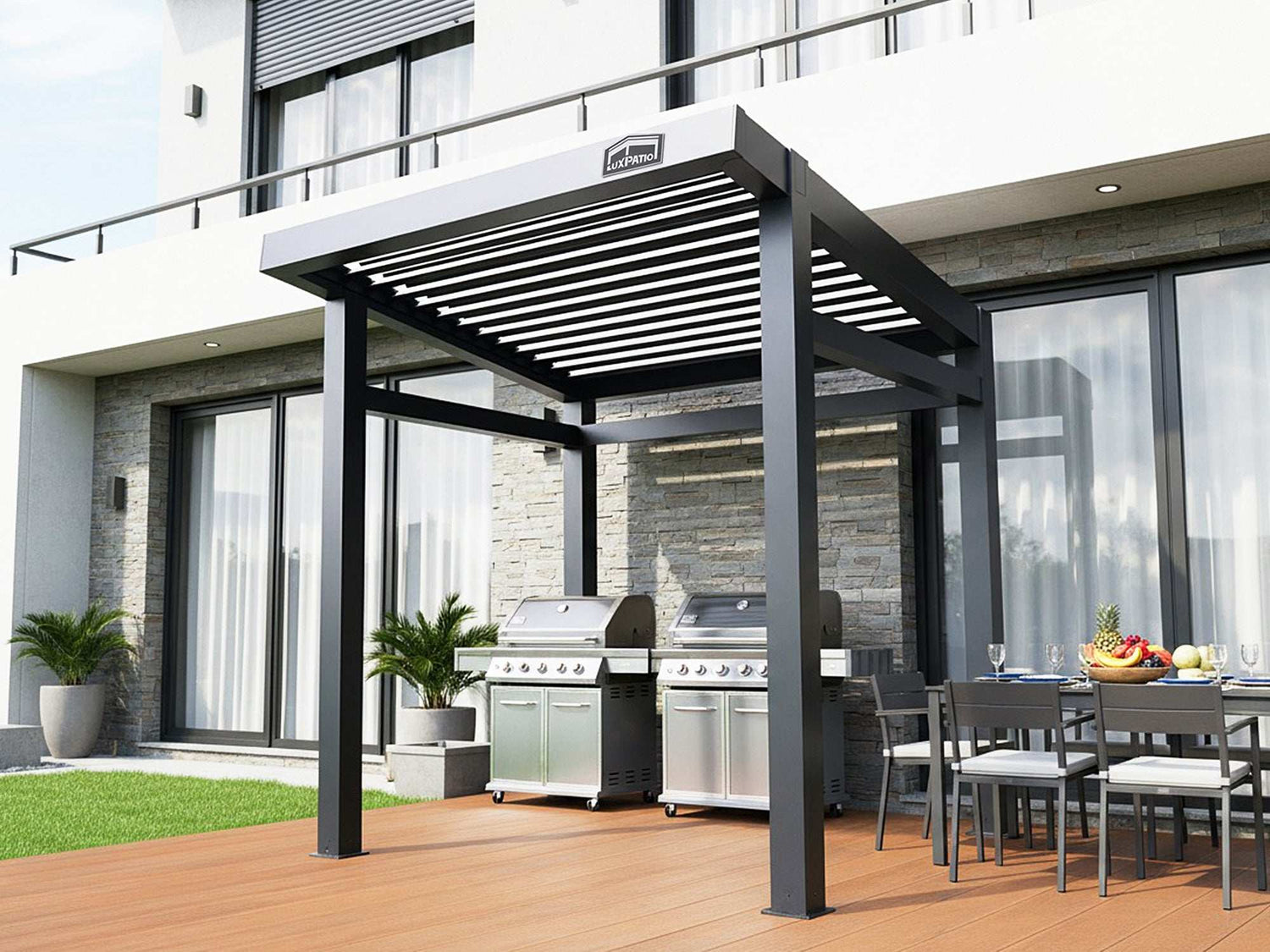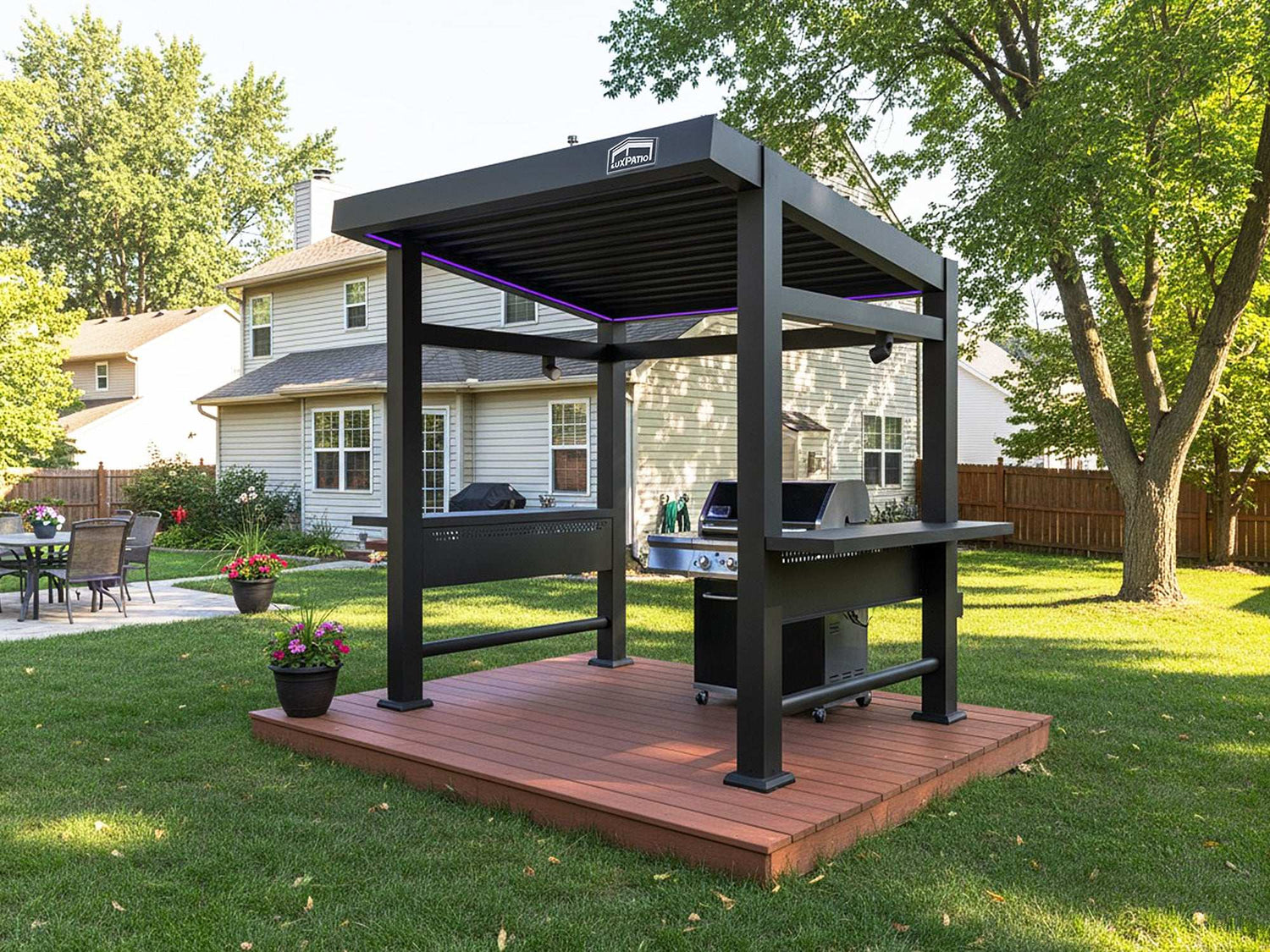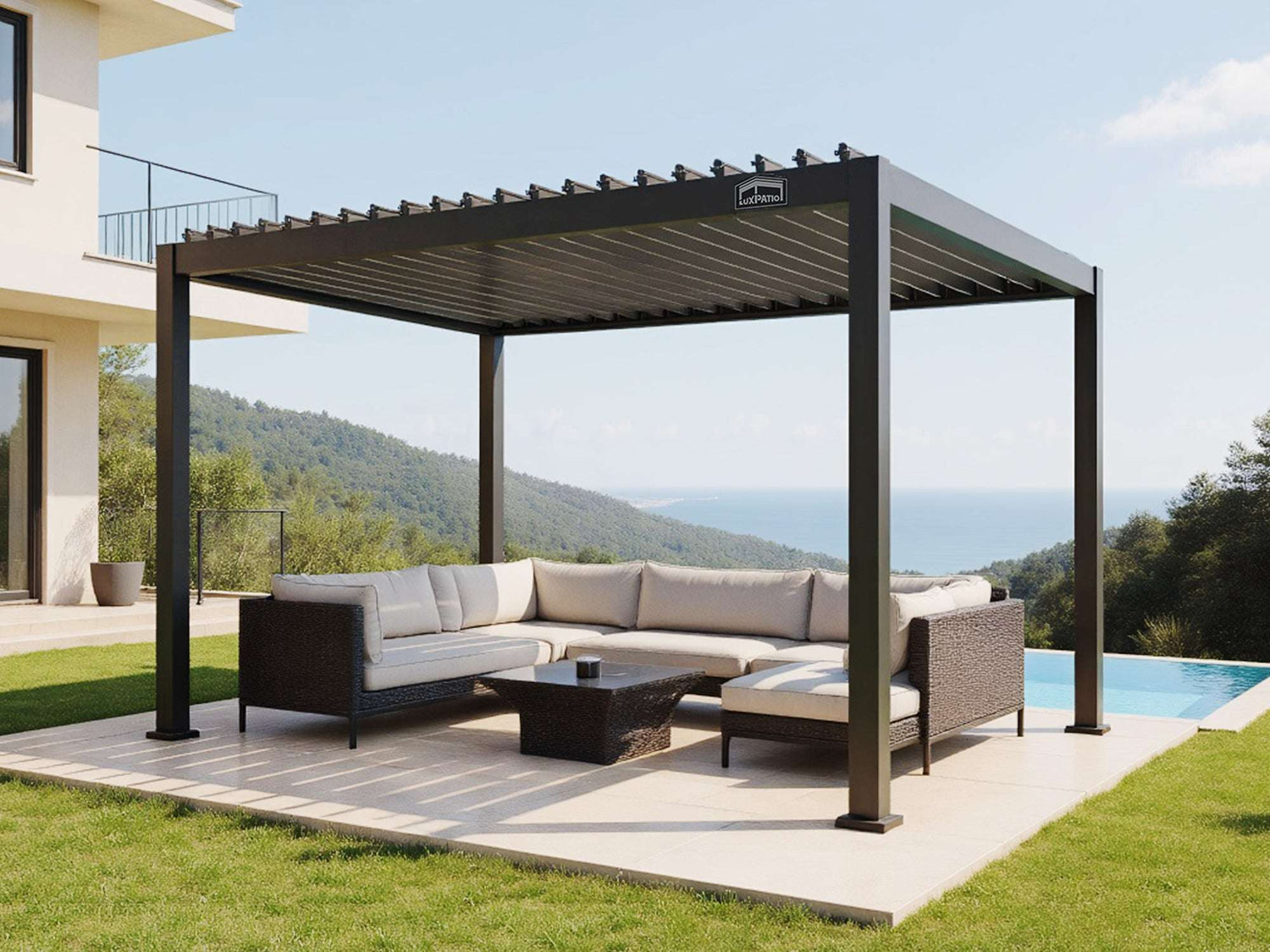A pergola is a wonderful addition to any home. It's the perfect spot for relaxing and spending time with family. To keep your pergola in great shape, a little maintenance is all you need. Taking care of it now means you can enjoy it for many years. This guide is here to show you how with simple, clear advice that anyone can follow.
Caring for Your Pergola Starts with Its Material
To take good care of your pergola, you first need to know what it's made of. Different materials have different needs. Most commonly, you see these three pergola materials: aluminum, steel and wood. Each has its own characteristics and needs different care. The way you care for a metal pergola is definitely not the same as how you care for a wooden one.
To get a quick knowledge, look at this chart:
Pergola Care Quick Guide
| Material | Key Features | How to Care |
| Aluminum |
• Rust-proof & lightweight • Very low maintenance |
• Wash with soap and water. • Paint over any scratches. • Check screws once a year. |
| Steel |
• Very strong & heavy • Can rust if scratched |
• Wash with soap and water. • Repaint scratches immediately. • Use rust-proof screws. |
| Wood |
• Natural look • Needs regular care |
• Clean dirt and mildew yearly. • Re-seal or re-stain every 2-3 years. • Check for rot, cracks, and insects. |
Now, let's explain in more detail why the most common materials—aluminum, steel, and wood—need this specific kind of care.

Aluminum: Rust-Proof and Light, but Susceptible to Damage
Aluminum is a very light metal that is chemically stable. A pergola made from aluminum has these same great features. People choose it for its modern, simple, and efficient design. You will not need to spend much time to maintain an aluminum pergola. If you understand its features and care for it the right way, it will stay beautiful and work well for a much longer time.
Core Features: Aluminum is very stable and does not rust. It naturally forms a tough protective film on its surface. Its main protection is a powder coat. Makers apply this hard surface when they spray on the paint with static electricity and then bake it at a high temperature. This process creates a finish that is much tougher and resists scratches better than regular paint.
How to Clean It Routinely
If you only rinse the pergola with water, you will only remove loose dust. A pergola sits outside all year, so it collects more stubborn dirt. This includes residue from acid rain, bird droppings that can cause damage, pollen, and industrial dust. If you do not clean these off, the sun can bake them onto the surface. They will become hard to remove and can slowly make the finish look dull.
Deep Care Steps: We recommend that you deep clean the pergola once a year. Use a mild, pH-neutral soap (like a gentle car wash soap) and a microfiber cloth. A neutral soap will not harm the coat, and a soft cloth will remove dirt but not cause scratches.
How to Handle Scratches and Dings
Aluminum itself does not rust. However, you can damage the powder coat surface if you drag furniture, hit it with hard objects, or scrape it with tree branches. A break in the coat creates a weak spot.
Deep Care Steps: For small scratches, you can use an automotive polish to buff the area. This will restore the shine. For deep scratches or dings that show the bare metal, you must perform a repair. First, clean the damaged area with alcohol. Then, use a special outdoor-grade touch-up paint that matches your pergola’s color. Use the paint to touch up the spot. You should do this not just so it looks good. You also need to stop moisture from getting into damaged spot. If moisture gets under the coat, it could cause the paint to bubble or peel over time.
Steel: Stable, but It Can Rust
Steel is a very strong alloy made of iron and carbon. A pergola made from steel has great structural stability and can hold a lot of weight. However, the main part of steel is iron, and iron can rust. For this reason, all the work you do to maintain a steel pergola has one goal: you must protect its surface to stop any chance of rust.
Core Features: The main element in steel is iron. Iron is chemically active. It will rust when it comes into contact with water and oxygen. The paint on the steel is the only thing that separates it from the outside world.

How to Inspect and Maintain the Coat
The condition of the paint coat is vital for steel. You should look for obvious scratches. You also need to pay special attention to weld points, the edges of screw holes, and the joints in the structure. Makers may apply a thinner coat of paint in these areas, or these spots may be under more stress. This makes them common places for rust to start.
Deep Care Steps: You should complete a full visual check at least once a year. Touch these key areas to feel if the coat is smooth. After you clean the structure, you must dry it completely. This will stop water from pooling in the joints.
How to Deal with a Damaged Coat
A scratch is a break in the pergola's defense. The problem with rust is that it spreads. It moves sideways and also creeps down under the paint. What looks like a small rust spot on the surface can hide a much larger area of damage underneath.
Deep Care Steps: To treat a scratch, you need to follow these steps:
- Use fine-grit sandpaper. Gently sand away any rust. Make the edges of the scratch smooth.
- Use a solvent like alcohol to completely clean the area. This removes all oil and dust.
- Apply a rust-blocking primer. This is the key step to stop new rust.
- After the primer dries, apply a top coat of paint that matches the pergola's color.
Wood: Elegant, but It Changes
The wooden pergola is a classic style. Wood is a natural, organic material. A pergola made from wood has a warm beauty that fits well in a natural setting. But because it is a living material, it will always react to its environment. It breathes, expands, shrinks, and ages. To maintain a wooden pergola, you must expect these changes and act to protect it.

Core Features: Wood has a porous, fibrous structure. This means it absorbs and releases water. As it swells and shrinks, it creates stress inside the wood. Wood is also full of cellulose, which attracts fungi that cause rot and insects that cause damage. These things will make the wood decay faster.
Fight Against Water—How to Prevent Rot and Cracks
Moisture is the biggest enemy of wood. Compared with aluminum materials, wooden materials require more maintenance. When the wood fibers get full of water, fungi that cause rot start to grow. When the wet wood dries quickly in the sun, it shrinks at different rates. This causes the wood to warp and crack. The areas with the most risk are the bottoms of the posts that touch the ground, the tops of the beams where water can sit, and the joints where pieces connect.
Deep Care Steps: To protect wood, you must control how much moisture it holds. You need to apply a protective coat every 2 to 3 years. Some penetrating wood oils soak deep into the wood to feed the fibers and repel water from the inside. Other film-forming paints and wood waxes create a physical protective layer on the surface. Before you apply a new coat, you must prepare the surface. You have to clean it completely. You also should lightly sand any old, rough areas so the new coat can stick well.
Block the Sun—How to Resist UV Damage
The sun's ultraviolet (UV) rays are the main reason wood ages. They break down the lignin inside the wood. Lignin is the "glue" that holds the wood fibers together. When the sun destroys the lignin, the wood surface becomes loose and weak, and its color fades to a grayish-white.
Deep Care Steps: A gray wood surface does not look good. Its structure is also damaged, so it will absorb more water. This makes the wood rot faster. For this reason, the protective coat you choose must contain UV blockers. Usually, wood oils or paints that have color give better sun protection than clear coats. The color particles in the finish act to reflect or absorb the UV rays.
Annual Health Check—How to Perform Preventive Maintenance
If you wait until you see obvious rot or large cracks in the wood, the repairs can be very expensive. The key is to check it every year and fix problems when they are small.
Deep Care Steps: Create a checklist to inspect the wood:
- Use the tip of a screwdriver to gently poke key areas. Check the bottoms of posts and the ends of beams to see if they feel soft.
- Look closely for any small holes or a fine powder that looks like sawdust. These are signs of pests.
- If you find small cracks that do not affect the structure, use a flexible wood filler or epoxy to fill them. You should do this before you apply a new protective coat. This will stop water from getting inside through the cracks.
- Check that all the metal hardware is tight. The wood's movement can cause screws and bolts to become loose.
Your Year-Round Pergola Maintenance Plan
Besides caring for your pergola based on its material, you can also do seasonal maintenance.
Spring: Give It a Good Check and a Cleaning
What to do: In the spring, give your pergola a full check-up. The cold winter weather can make screws come loose or damage parts of it. Before you start using it a lot, look it over carefully to make sure everything is safe and tight. You should also wash off all the winter dirt and mold to make it look fresh.
Summer: Let the Rainwater Drain Off
What to do: The most important thing in the summer is to make sure rainwater can drain away. Check the gutters or drains to make sure they are not blocked with leaves. If they are blocked, a heavy rainstorm can cause water to get stuck on the roof. This puts a lot of weight on the pergola all at once and can cause leaks or damage.
Fall: Keep it Clear of Wet Leaves
What to do: The biggest problem in the fall is wet leaves. They can pile up on your pergola and in the drains. This keeps the surfaces wet all the time, which can make wood rot, damage the paint on metal, and help mold grow. The main thing to do in the fall is to clear the leaves away and keep your pergola dry.
Winter: Keep Heavy Snow Off of It
What to do: The biggest danger in the winter is heavy snow. Wet snow weighs a lot. If the snow on your roof is heavier than the pergola was built to handle, it can bend the beams or even cause it to break. The most important job is to clear the snow off after a big storm.
Enjoy Your Oasis for Years to Come
Regular maintenance will help keep your pergola in good condition for years. These simple steps don't take much time, but they make a real difference in how your pergola looks and lasts. If you're looking for a low-maintenance option, consider aluminum pergolas from LuxPatio. They require less upkeep than other materials, giving you more time to enjoy your outdoor space.
Frequently Asked Questions
Q1: What should I do if my pergola roof is leaking?
A leak is almost always caused by a blockage or a failed seal. Start by thoroughly cleaning the gutter system. If the leak continues, it’s likely coming from a seam. Applying a thin, even bead of high-quality, outdoor-rated clear silicone sealant along the joints where the panels meet the frame will usually solve the problem for good.
Q2: How can I fix a single broken louver on my aluminum pergola?
First, contact your manufacturer to order a replacement louver. The process is usually straightforward: you will likely need to remove a side cover or connecting strip that links the louvers. Then, you can carefully unscrew the hardware holding the damaged louver to its rotating mechanism, slide it out, and install the new one by reversing the process.
Q3: How can I make my pergola more resistant to high winds?
Proper anchoring is the most critical factor. Ensure your pergola is securely fastened to a concrete slab or deck footings that meet your local building codes. For louvered-roof pergolas, opening the louvers during a high-wind event allows air to pass through, reducing the force on the structure. Adding an aluminum slat wall or a decorative screen on the side that faces the prevailing wind can also act as an effective windbreak.










